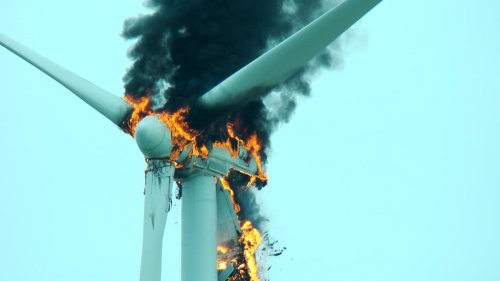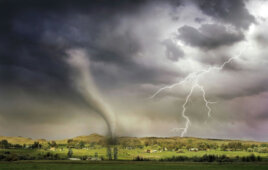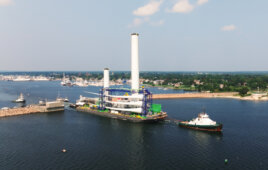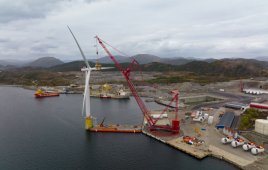By Angela Krcmar, Global Sales Manager, Wind, Firetrace International
The American wind industry has stayed resilient through a difficult year, with a positive outlook for development in the years ahead. However, in order to continue to grow and thrive throughout this crisis, owners and operators cannot afford to be complacent around fire risk. A high-profile fire can not only devastate current projects, but also jeopardize the prospects of future development across the industry – and this risk only grows as turbines get bigger and move into more remote sites on- and offshore.
However, to date, the industry has underestimated the risk and cost of wind turbine fires. Even assuming an average of one fire per 2,000 turbines per year, based on incomplete reporting of fire incidents, a wind farm can expect to face one to two fires over the course of its operational lifetime. If the industry is to take action to prevent unsustainable losses from fire, owners and operators must first understand how much fires truly cost, how incidents start and what action can be taken to protect against fires.
The true cost of a fire incident
A fire incident at a turbine can cost up to $4.5 million, according to a GCube report from 2015 – and as turbines have grown in size and upfront cost, this figure is likely to have increased dramatically. Assuming an average wind turbine costs $1 million per megawatt of generating capacity, offshore wind turbines ranging from 3 to 10 MW can cost up to $10 million, which would need to be paid up-front if out of warranty. Additionally, once a fire starts, the project must be shut down and taken off grid for a period of time as a safety precaution, resulting in lost revenue.
Turbine fires can have costs beyond the wind farm. A fire can spread down the tower to land surrounding the project if not carefully managed. This can potentially result in wildfires, causing extensive damage to the wider area and ultimately leading to significant reputational damage not only for the individual site but for the industry as a whole.
How do fires start?
Wind turbines catch fire for the same reasons as other heavy machinery – components inside the turbine fail, generating heat or sparks and igniting flammable materials such as plastics, resins, fiberglass and hydraulic lubricants. Most turbine fires originate in the nacelle, typically at three points of ignition: converter and capacitor cabinets, nacelle brake and transformer.
The most common location for an electrical fault in a wind turbine is the converter cabinets and capacitor cabinets in the nacelle. When an electrical fault produces an arc flash or sparks, surrounding plastics in the electrical cabinet can quickly ignite other sources resulting in total loss of a nacelle.
Transformers, located in the nacelle or at the base of a turbine, are the second most-common ignition point for wind turbine fires. Transformers convert energy into the appropriate voltage for the electrical grid, and as with converter and capacitor cabinets, sparks and arc flashes due to electrical faults can lead to a fire.
The nacelle brake, which is commonly found behind the gearbox, is another component that can be an ignition point, albeit due to friction rather than electrical failure. In an emergency, the nacelle brake stops the turbine’s blades from spinning. The mechanical braking system can generate a huge amount of friction and heat, sometimes resulting in a fire. While newer turbines may feature electric braking systems, which are less susceptible to fire, mechanical brakes are often used as back-ups to electrical braking systems.
From a single spark to irreparable damage
According to the Office of Energy Efficiency and Renewable Energy, the average wind turbine hub height has grown from 20 m to 88 m since the 1980s in order to access higher wind speeds. However, this height also means the nacelle is often out-of-range for ground-based firefighting. Sending a team up the tower to manually fight the fire constitutes a significant health and safety risk. If the fire is left to burn, the whole turbine can be damaged beyond repair in a matter of hours.
Offshore wind turbines are at particular risk of severe damage from fire, due to the remote nature of offshore project sites. Since many sites are situated at least 45 minutes from shore, in the event of a fire, an emergency response team is unlikely to arrive in time to prevent significant and irreparable damage.
Cost-benefit of fully protecting against fires
In order to reduce the severity of nacelle fires, automatic fire suppression systems must be installed at the main points of ignition. While preventative technology such as arc flash detection and condition monitoring systems can reduce the risk of a fire, only suppression systems can put a fire out once it has started.
Firetrace is one of the few experienced providers of these systems, which are designed with flexible heat detection tubing. Once a fire breaks out, this tubing ruptures and a suppression agent is released automatically through the tubing or via nozzles nearest the point where the most heat is detected, extinguishing the fire precisely where it starts and before it can take hold.
Once a turbine’s capacity exceeds 3 MW, the cost of fire suppression to protect all three risk areas is outweighed by the cost of replacing that turbine. Installation of fire suppression systems at all three ignition sources typically costs less than $30,000 – less than 1% of the average installation cost of a 3-MW onshore wind turbine and less than 0.6% of the average cost of a fire loss. When factoring in the average frequency of one to two fire incidents over the course of a wind farm’s lifetime, the benefit of full protection of all ignition points outweighs the cost of installation.
The unintended consequences of a fire incident in a wind turbine can have far reaching operational, safety and health risks. By investing in fire suppression, owners, operators and their insurers can prevent not only the immediate, short-term costs of wind turbine replacement, but also the long-term reputational risk. If the wind industry is to thrive in the coming years, it must take action to manage and protect against fire incidents.
 Angela Krcmar has over 10 years of experience in the fire protection industry focusing on the renewable sectors including wind and battery storage. For the past 10 years Mrs. Krcmar has led Firetrace efforts in the wind industry, contacting and visiting wind farms, owners and manufacturers in an effort to discuss needs and advantages of fire protection for wind applications. With the increases in the size and value of turbines, the cost of potential equipment losses, employee safety, downtime and increases in insurance premiums the need for fire protection is rapidly being recognized and owners, operators and manufacturers are now exploring their options.
Angela Krcmar has over 10 years of experience in the fire protection industry focusing on the renewable sectors including wind and battery storage. For the past 10 years Mrs. Krcmar has led Firetrace efforts in the wind industry, contacting and visiting wind farms, owners and manufacturers in an effort to discuss needs and advantages of fire protection for wind applications. With the increases in the size and value of turbines, the cost of potential equipment losses, employee safety, downtime and increases in insurance premiums the need for fire protection is rapidly being recognized and owners, operators and manufacturers are now exploring their options.
Mrs. Krcmar is an active member of the AWEA Wind Environmental, Health, and Safety Standards Committee Meeting, member of the NFPA 855 Committee for Standard for the Installation of Stationary Energy Storage Systems and contributing member of the UL 6141 technical standards panel.
Filed Under: Featured







Does anyone know who took the first picture on this page of the flames and burning Turbine?
I am amazed turbines have such little protection against fire, flash detection… there shouldn’t be a need
for flash detection, flash cannot exist without fault, clean systems cannot fault, they may not be currently
available but they will be, other systems can be protected by analysing systems which constantly assess
threat, it really isn’t that complicated, these fires are easily prevented.
I took that 2nd pic! 🙂
What are the statistics of spray fires in/on wind turbine machines?
These are mechanically rotating with power producing package there has to be fire extinguishing system we can provide the package as well as monitoring system that the FFA is intact and good for all times
This article does not distinguish between gearbox turbine and gearless turbines (also called direct drive). There is hardly any incident of fire in gearless wind turbine. I have been in industry for 15 years, never seen a gearless/ direct drive catch fire. I guess almost all the off shore wind turbines are gearless technology and do not have gearbox. Still a fire protection system can be made mandatory.
Fire trace only reacts when the heat is on. Smoldering fires should be detected with smoke aspiration systems and suppression should start before a fire lits up. Best to do with Inergen ( lowering oxigen level to less than 15% and keep it that way for at least 10 minutes as per classification requirements, so no fire can start at all). This is what we install for over a decade in onshore and offshore wind turbines. No damage to the cabinets after fire suppression.
This was informative and brief touching all the key points. Especially the 3 most likely areas of ignition. Would like to see some details of the total number of turbine fires world wide over time. Is it getting better or worse ?
I learned something new today – that makes it a great day!
Thanks for this piece.
Vr,
Keith W. Finnerty
Master Mariner